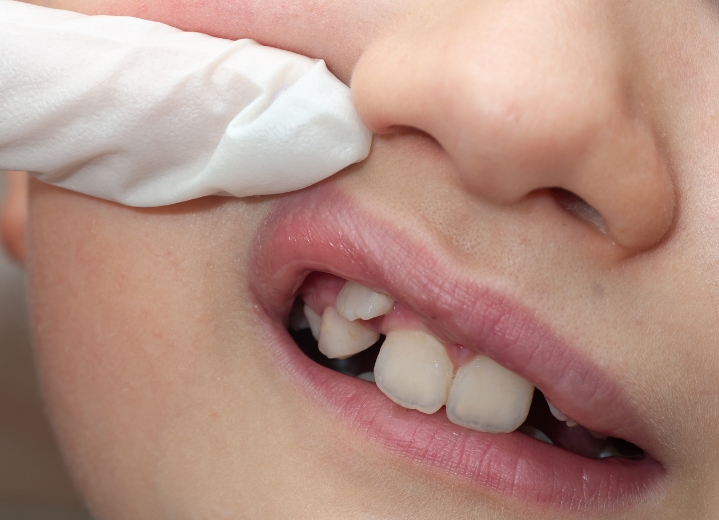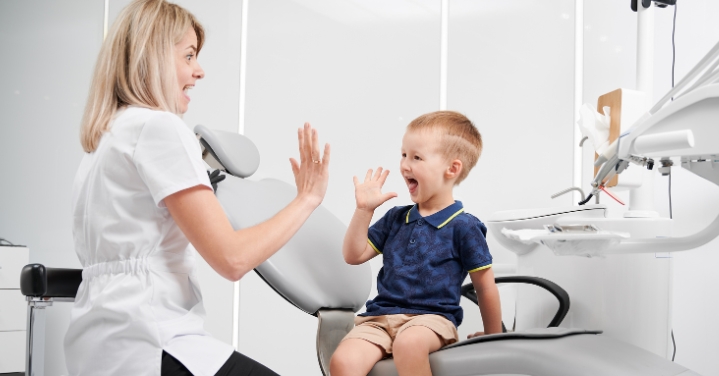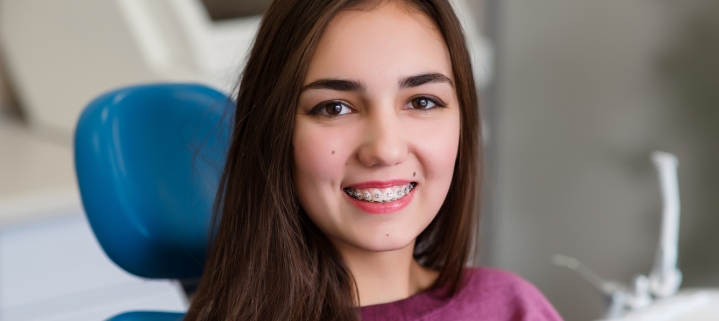Orthodontics For Children
Orthodontic treatment not only enhances your smile but also promotes improved oral health and self-confidence.
For children, orthodontics plays a crucial role in maximizing their genetic potential by aligning teeth, aiding proper growth, enhancing facial symmetry, and ensuring healthy airways and jaw joints. These benefits lead to better sleep quality, overall growth, and general well-being. Addressing minor orthodontic issues promptly is essential, as they worsen over time and become more challenging to treat later on.
When to treat children
Orthodontic treatment is successful when a child is willing and able to handle dental visits and orthodontic appliances. While our preference is to start treatment as soon as issues are identified, it’s not always possible. In such cases, we regularly check the child’s progress until they are ready and comfortable to begin the treatment.

When to treat children
Orthodontic treatment is successful when a child is willing and able to handle dental visits and orthodontic appliances. While our preference is to start treatment as soon as issues are identified, it’s not always possible. In such cases, we regularly check the child’s progress until they are ready and comfortable to begin the treatment.
What does early orthodontic treatment involve?
Early orthodontic treatment, also known as interceptive orthodontics, occurs while children still have their primary teeth. It involves managing the movement of teeth, addressing alignment issues, and correcting improper growth patterns of permanent teeth during this stage. Interceptive orthodontics enables us to focus on developing the upper and lower jaws to their full genetic potential while the patient is still in their young and growing phase. Since children undergo 90% of their facial growth by the age of 12, intervening during this period allows for optimal health, functionality, and cosmetic outcomes. This aligns with the primary objective of early orthodontic treatment, often referred to as first phase treatment.

What does early orthodontic treatment involve?
Early orthodontic treatment, also known as interceptive orthodontics, occurs while children still have their primary teeth. It involves managing the movement of teeth, addressing alignment issues, and correcting improper growth patterns of permanent teeth during this stage. Interceptive orthodontics enables us to focus on developing the upper and lower jaws to their full genetic potential while the patient is still in their young and growing phase. Since children undergo 90% of their facial growth by the age of 12, intervening during this period allows for optimal health, functionality, and cosmetic outcomes. This aligns with the primary objective of early orthodontic treatment, often referred to as first phase treatment.
What are the advantages of early treatment?
Orthodontic treatment is simpler when issues are in their initial phases. Moreover, younger children are generally more cooperative and less self-conscious compared to pre-teens or young adults, making the treatment process smoother. Addressing orthodontic problems early can minimize or even eliminate the necessity for extensive treatment later on. It often decreases the likelihood of extracting healthy permanent teeth due to crowding or lack of space as well.

What are the advantages of early treatment?
Orthodontic treatment is simpler when issues are in their initial phases. Moreover, younger children are generally more cooperative and less self-conscious compared to pre-teens or young adults, making the treatment process smoother. Addressing orthodontic problems early can minimize or even eliminate the necessity for extensive treatment later on. It often decreases the likelihood of extracting healthy permanent teeth due to crowding or lack of space as well.
Braces for Kids
Braces work by exerting consistent pressure on the teeth, gradually moving them into proper alignment and correcting issues like crooked or overlapping teeth. Typically, children’s braces consist of brackets affixed to the teeth, connected by a wire and rubber bands. The wire is tightened gradually throughout the treatment.

Braces for Kids
Braces work by exerting consistent pressure on the teeth, gradually moving them into proper alignment and correcting issues like crooked or overlapping teeth. Typically, children’s braces consist of brackets affixed to the teeth, connected by a wire and rubber bands. The wire is tightened gradually throughout the treatment.
Braces for Teenagers
Teenagers prefer inconspicuous options like clear aligners (Invisalign, SureSmile) over traditional metal braces. Clear Aligners, similar in design to retainers, is practically invisible. These customized aligners are created from scans of the patient’s teeth and are suitable for minor cases. The plastic aligners need to be replaced every one to two weeks based on new impressions of your teen’s teeth. Contact us to schedule a consultation and explore the most suitable choices for your child.

Braces for Teenagers
Teenagers prefer inconspicuous options like clear aligners (Invisalign, SureSmile) over traditional metal braces. Clear Aligners, similar in design to retainers, is practically invisible. These customized aligners are created from scans of the patient’s teeth and are suitable for minor cases. The plastic aligners need to be replaced every one to two weeks based on new impressions of your teen’s teeth. Contact us to schedule a consultation and explore the most suitable choices for your child.
Types of braces for children
Orthodontic Appliance
There is a common misconception that crooked teeth in children can only be corrected once all permanent teeth have erupted. However, early intervention using removable or fixed orthodontic devices, or growth guidance appliances, can effectively guide the proper growth of the upper and lower jaws. This not only reduces the extent of orthodontic treatment required when children are older but also minimizes the associated costs. Children’s facial development is 60% complete by age 6 and 90% by age 12. Intervening at a younger age allows us to harness your child’s most significant growth period, making the treatment process much simpler.
Functional Orthodontics
Functional orthodontics focuses on aligning the disparity between the positions of the upper and lower jaws. When combined with braces, these methods are employed to not only straighten teeth but also to correct the alignment of both the upper and lower jaws. This approach aims to achieve a balanced facial profile and prevent issues such as a weak chin, as well as misaligned jaws that can cause overbites or underbites. Addressing these conditions is crucial as they have been associated with more serious problems, including migraines, sleep apnea, and upper airway obstructions.
Non-extraction Orthodontics
In traditional orthodontic methods, it’s common to remove teeth to create additional space in the mouth. However, non-extraction orthodontic treatment has become the new norm, minimizing the need for extractions in most cases. At Affordable Dentists, we advocate for this non-extraction approach. Instead of extracting teeth, our treatment plans focus on expanding the jaws to achieve broad, complete smiles. This approach offers several advantages, including preserving tongue space, ensuring unobstructed airways, and maintaining balanced jaw relationships. Non-extraction orthodontics is also referred to as full face orthodontics.
Growth Guidance Orthodontics
Facial development starts early and reaches 60% completion by the age of six. Growth guidance orthodontics focuses on identifying and correcting developmental issues in children at an early stage, promoting healthy facial development. Utilizing tools like growth appliances, including anterior growth guidance appliances, orthodontists can modify abnormal growth patterns. This intervention ensures a functional bite, proper oxygenation through an unobstructed airway, and, importantly, a complete and attractive smile. Children around seven years old are ideal candidates for growth guidance orthodontics, as they have started getting their permanent teeth by this age.
